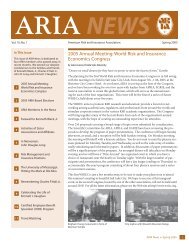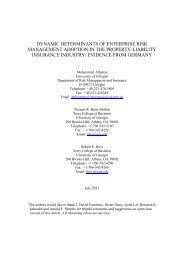EX-POST BEHAVIOR IN INSURANCE MARKETS* Greg Nini ...
EX-POST BEHAVIOR IN INSURANCE MARKETS* Greg Nini ...
EX-POST BEHAVIOR IN INSURANCE MARKETS* Greg Nini ...
You also want an ePaper? Increase the reach of your titles
YUMPU automatically turns print PDFs into web optimized ePapers that Google loves.
The first contribution of this paper is to identify an example where additional insurance<br />
leads to a marked change in outcomes. Insureds purchasing this Rating Protection have<br />
significantly more claims than insureds not purchasing the protection. This result is<br />
important since prior research has frequently found at most a small relationship between the<br />
amount of insurance purchased (e.g. the size of a deductible) and the probability of a claim.<br />
Finding that insureds respond to the incentives provided by contracts restores some<br />
credibility to the rationality of the consumer and our economic models used understand<br />
behavior.<br />
The more noteworthy contribution of the paper is to document that the significant<br />
difference in outcomes appears principally attributable to actions taken after an accident<br />
occurs. The data suggest that insureds frequently choose not to make claims for accidents<br />
that happen, but this effect is muted by the purchase of Rating Protection. While the<br />
positive correlation between Rating Protection and claim frequency is consistent with both<br />
adverse selection and ex-ante moral hazard, the empirical results suggest that the driving<br />
force for the difference in claim frequency is that insureds without Rating Protection are<br />
considerably more likely to hide their accident and not make a claim on the policy. Such<br />
behavior is a rational response to the incentives provided by the experience rating system<br />
used in Australia. The lack of significant evidence of ex-ante moral hazard or adverse<br />
selection is consistent with prior literature on auto insurance that fails to find a positive<br />
correlation between claims and the amount of insurance after controlling for observable<br />
rating variables.<br />
The impact of under-reporting is first identified by a series of reduced form comparisons<br />
of the claim severity distributions and the claim type (at-fault vs. no fault) distributions for<br />
insured with and without Rating Protection. Regression results suggest that policies with<br />
Rating Protection have significantly smaller claims on average than policies without<br />
protection, consistent with policies having Rating Protection having additional small claims.<br />
This conclusion is supported by Probit regressions that estimate the likelihood that a policy<br />
2






